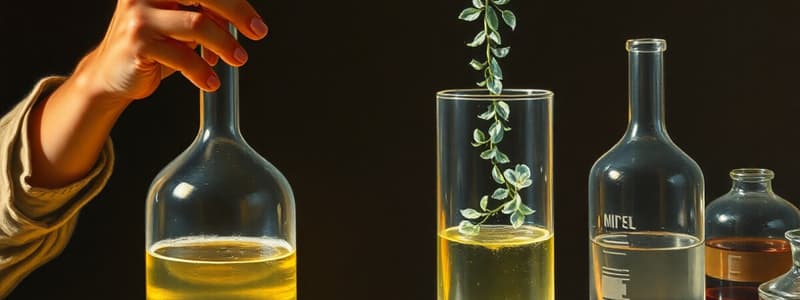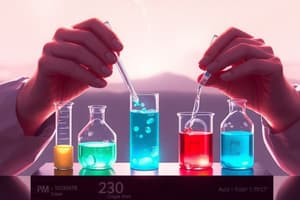Podcast
Questions and Answers
What type of reaction occurs between an acid and a base?
What type of reaction occurs between an acid and a base?
neutralization
What two products are typically formed in a neutralization reaction?
What two products are typically formed in a neutralization reaction?
salt and water
What is the purpose of a titration in chemistry?
What is the purpose of a titration in chemistry?
to determine the concentration of a substance in a solution
In a titration, what is the name of the solution of known concentration that is used?
In a titration, what is the name of the solution of known concentration that is used?
What is the term used for the solution inside the burette during a titration?
What is the term used for the solution inside the burette during a titration?
What is the specific term for the point in titration where neutralization is complete?
What is the specific term for the point in titration where neutralization is complete?
What does an indicator do in a titration?
What does an indicator do in a titration?
According to Table 2, what color does phenolphthalein turn in a basic solution?
According to Table 2, what color does phenolphthalein turn in a basic solution?
What is the term for the point in a titration when the reaction between two chemicals is judged to be complete?
What is the term for the point in a titration when the reaction between two chemicals is judged to be complete?
What observable change indicates the 'endpoint' of a titration?
What observable change indicates the 'endpoint' of a titration?
How many trials are recommended during a titration to improve the reliability of the results?
How many trials are recommended during a titration to improve the reliability of the results?
What type of environmental analysis is titration used for?
What type of environmental analysis is titration used for?
In the provided practice problem 1, what is the average volume of NaOH(aq) added during the titration of HCl(aq)?
In the provided practice problem 1, what is the average volume of NaOH(aq) added during the titration of HCl(aq)?
In practice problem 1, what is the final burette reading for the second trial?
In practice problem 1, what is the final burette reading for the second trial?
Why should the reaction with the titrant be stopped at the endpoint?
Why should the reaction with the titrant be stopped at the endpoint?
In addition to environmental analysis, name one other application of titration.
In addition to environmental analysis, name one other application of titration.
Flashcards
Neutralization Reaction
Neutralization Reaction
A reaction between an acid and a base that results in the formation of a salt and water.
Titration
Titration
A method used to determine the concentration of a substance in a solution by reacting it with a solution of known concentration.
Burette
Burette
A device used to dispense specific amounts of a chemical solution.
Standard Solution
Standard Solution
Signup and view all the flashcards
Titrant
Titrant
Signup and view all the flashcards
Equivalence Point
Equivalence Point
Signup and view all the flashcards
Endpoint
Endpoint
Signup and view all the flashcards
Indicator
Indicator
Signup and view all the flashcards
Analyte
Analyte
Signup and view all the flashcards
Titrant Volume
Titrant Volume
Signup and view all the flashcards
Multiple Trials
Multiple Trials
Signup and view all the flashcards
Study Notes
Acid-Base Titration
- A neutralization reaction is a reaction between an acid and a base.
- The general equation for a neutralization reaction is: acid + base → salt + water.
- Example: HCl(aq) + KOH(aq) → HOH(l) + KCl(aq)
Titration
- Titration is a common method of quantitative chemical analysis.
- It's used to determine the concentration of a substance in a solution.
Titration Terminology
- Burette: A device used for dispensing specific amounts of a chemical solution.
- Standard Solution: A solution with a known concentration.
- Titrant: The solution in the burette during a titration.
- Equivalence Point: The point during titration when neutralization is complete.
- Endpoint: The point during titration where a sharp change in solution color occurs.
- Indicator: A substance that changes color at the endpoint to show when the reaction between two chemicals is complete.
Steps for Titrating
- A known volume of the sample is transferred into a flask. The concentration of this solution is unknown.
- A few drops of indicator are added to the solution in the flask.
- The burette is filled with the known concentration solution (standard solution).
- The solution in the burette is called the titrant.
- An initial burette volume reading is taken.
- The titrant is added drop by drop to the sample in the flask.
- The titrant is added until the reaction is judged complete or the neutralization is complete, reaching the equivalence point.
- The indicator in the flask will change color at this point (endpoint).
- At the endpoint, no more titrant is added.
- The volume of titrant used (final burette reading) is recorded.
- This information is used to calculate the concentration of the solution in the flask.
- At least 3 trials are performed during a titration to improve the reliability of the results (i.e., for calculating concentration).
Indicators
- Indicators change color depending on whether the solution is acidic or basic, crucial for determining the endpoint in a titration.
- Examples include: Litmus, Methyl orange, Bromothymol blue, Phenolphthalein. Litmus changes from red to blue in basic solution; methyl orange from red to yellow. Bromothymol blue changes from yellow to green in a basic solution; phenolphthalein changes from colorless to red.
Practice Problems
- Practice problems include calculating the concentration of HCl using titration with NaOH, and calculating the concentration of hydrochloric acid using sodium carbonate. Data tables provide the specific readings needed for these calculations.
Studying That Suits You
Use AI to generate personalized quizzes and flashcards to suit your learning preferences.




